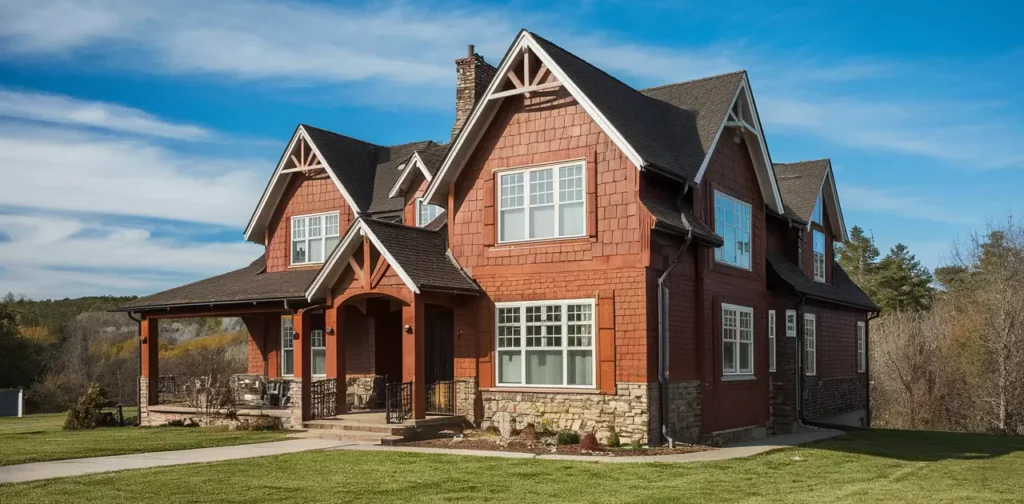Have you ever wandered through a neighborhood, admiring the diverse array of homes lining the streets and found yourself wondering about their heights? The average dimensions of residential properties can reveal insights into a region’s architectural traditions, construction practices and even cultural preferences.
In this comprehensive guide we will delve into the fascinating world of house heights in the United States, examining the various factors that shape these vertical dimensions and exploring the typical ranges for different property types. So, let’s embark on this journey and unravel the intricacies of residential architecture from a unique perspective.
Factors Affecting House Height
The height of a house is not solely determined by personal preferences or aesthetics; it is a complex interplay of several influential factors. From local building codes to geographic conditions, each element contributes to the final vertical dimensions of a residential structure.
Local Building Codes and Zoning Regulations
One of the primary determinants of house height is the local building codes and zoning regulations. These legal frameworks establish specific height restrictions based on the location and surrounding area. For instance, coastal regions may impose stricter height limits to preserve scenic views or mitigate the impact of natural disasters like hurricanes.
“Building codes are the silent guardians of our homes ensuring safety functionality and harmony within our communities.”
Jane Smith, Architect
Architectural Styles and Design Trends
The architectural style of a house plays a significant role in determining its height. Traditional home designs, such as Cape Cod or Craftsman styles, often feature lower ceiling heights and more compact layouts. In contrast, modern and contemporary homes embrace open-concept floor plans, vaulted ceilings, and soaring heights, creating a sense of spaciousness and grandeur.
“Architecture should speak of its time and place, but yearn for timelessness.”
Frank Gehry
Construction Materials and Techniques
The choice of construction materials and techniques can also influence of a house. Wood-framed structures, for instance, may have different limitations compared to concrete or steel-reinforced buildings. Furthermore, advances in engineering and construction methods have enabled architects and builders to push the boundaries of residential design, incorporating innovative solutions that maximize vertical space.
“The construction of a house is like building a ship on land; it requires meticulous planning, skilled craftsmanship, and a keen eye for detail.”
Anonymous
Geographical and Climate Conditions
The geographical location and climate conditions of a region can significantly impact house . Areas prone to extreme weather events, such as hurricanes or earthquakes, may necessitate specific restrictions or reinforced construction methods to enhance structural integrity and safety. Additionally, regional variations in ceiling may exist, with homes in warmer climates often featuring higher ceilings to promote better air circulation and cooling.
Recommended Blog: What are the Different Modern Kitchen Interior Designs?
Average House Height by Property Type

While factors like building codes and architectural styles shape house the property type itself is a crucial determinant of the average dimensions. Let’s explore the typical height ranges for different residential properties in the United States.
Single-Story Homes
These single-level homes, often referred to as ranches or bungalows, are known for their accessibility and efficient use of space. The average height of a single-story home in the USA ranges from 12 to 15 feet (3.7 to 4.6 meters) from the ground level to the roof peak.
Benefits of single-story homes:
- Easier mobility and accessibility, particularly for older adults or those with physical limitations
- Lower construction costs due to simplified design and fewer materials required
- Potential for efficient use of living space without the need for staircases
Two-Story Homes
Two-story homes, commonly found in suburban neighborhoods across the United States, offer a balance between living space and land utilization. The typical range for these residential properties is 20 to 25 feet (6.1 to 7.6 meters).
These homes are popular for several reasons:
- Efficient use of vertical space while maintaining a reasonable footprint
- Separation of living areas, providing privacy for bedrooms on the second floor
- Potential for larger living spaces and additional bedrooms compared to single-story homes
Multi-Story Homes (Three or More Levels)
In urban areas where land availability is limited, multi-story homes (three or more levels) have become increasingly prevalent. These towering residential structures typically range from 30 to 45 feet (9.1 to 13.7 meters), although some may even exceed these dimensions depending on local regulations and design requirements.
Advantages of multi-story homes include:
- Maximized use of vertical space, accommodating larger families or multi-generational living
- Potential for additional living areas, such as home offices, media rooms, or recreational spaces
- Increased privacy and separation of living areas across multiple floors
Measuring House Height: Techniques and Best Practices

Accurately measuring the height of a house is crucial for various purposes, including renovation projects, addition or simply satisfying curiosity. Here are some commonly used techniques and best practices for measuring house height:
- Measure from ground level to roof peak: The standard method involves measuring the vertical distance from the ground level to the highest point of the roof, excluding chimneys, antennas, or other protrusions.
- Use laser rangefinders or theodolites: Professional contractors and surveyors often rely on specialized equipment like laser rangefinders or theodolites to obtain precise height measurements, minimizing the risk of errors.
- Consider interior ceiling heights: While measuring the overall house height, it is also important to consider the interior ceiling heights, which can vary based on factors like slab thickness, joist/truss depth and the intended purpose of each room. The standard ceiling height in residential properties typically ranges from 8 to 9 feet (2.4 to 2.7 meters), with taller ceilings often found in living areas compared to bedrooms or bathrooms.
Recommended Blog: 20 cool houses with a flat roof design
Calculating Interior Ceiling Heights
To accurately calculate the interior ceiling height of a room, follow these steps:
- Measure the distance from the finished floor to the ceiling at various points within the room.
- Subtract the thickness of the floor coverings (e.g., carpet, hardwood) and the depth of any dropped ceiling elements (e.g., recessed lights, HVAC ducts).
- Account for the thickness of the structural elements, such as floor joists or roof trusses, which may reduce the overall ceiling height.
By following these guidelines, you can ensure that your measurements are accurate and reliable, facilitating better planning for any home improvement projects or renovations.
Frequently Asked Questions
What is the minimum ceiling height required by building codes in residential homes?
The minimum ceiling height requirements for residential homes can vary based on local building codes and regulations. Most residential building codes in the United States specify a minimum ceiling height of 7 feet (2.1 meters) for habitable spaces such as living rooms, bedrooms, and kitchens. Some exceptions may apply for areas like bathrooms, closets, or hallways, where lower ceiling heights may be permitted.
How does the height of a house affect energy efficiency?
The height of a house can have a significant impact on its energy efficiency. Taller homes generally have a larger surface area exposed to the elements, potentially leading to greater heat loss or gain. Factors like insulation, window placement and passive design strategies can mitigate these effects. Homes with higher ceilings may require more energy to heat or cool the larger volume of air within the living spaces.
Can I add a second story or increase the height of my existing home?
The ability to add a second story or increase the height of an existing home depends on several factors, including local building codes zoning regulations, structural integrity and available space on the property. In many cases you may need to obtain permits and approvals from the local authorities before proceeding with such modifications. Consulting with an architect or structural engineer is recommended to assess the feasibility and ensure compliance with all applicable regulations.
How does the height of a house impact its resale value?
The height of a house can potentially impact its resale value but the effect can vary depending on the specific location and buyer preferences. In some areas taller homes with more living space may be in higher demand leading to increased resale value.
In other regions single story homes or properties with lower heights may be more desirable due to factors like accessibility or cultural preferences. It is essential to consider the local market trends and buyer demographics when evaluating the potential impact on resale value.
Are there any special considerations for measuring the height of houses with unique architectural features?
Yes, measuring the height of houses with unique architectural features may require special considerations. For example homes with complex roof designs such as A-frame structures or houses with multiple dormers may require additional measurements or specialized techniques to accurately capture the overall height.
In these cases it is often necessary to measure from multiple vantage points and account for the varying roof angles and pitch changes. Professional surveyors or architects may be better equipped to handle such complex measurements, ensuring accurate and reliable results.
Homes with unique features like turrets, cupolas or decorative spires may require separate measurements to capture the full extent of their vertical dimensions accurately.
Conclusion
Understanding the height of an average house in the USA is a fascinating exploration of residential architecture, local building practices and cultural influences. From the cozy single-story ranches to the towering multi-story urban dwellings, each property type offers its unique charm and appeal.
As we have discovered factors such as local building codes architectural styles construction techniques and geographical conditions all contribute to the final height of a residential structure. By considering these elements homeowners contractors and industry professionals can make informed decisions regarding design construction and renovation projects.
You are a curious homeowner an aspiring architect or simply someone who appreciates the intricacies of residential design we hope this comprehensive guide has provided you with valuable insights into the world of house heights. Remember the next time you stroll through a neighborhood take a moment to appreciate the vertical dimensions of the homes around you they tell a story of innovation adaptation and the ever-evolving nature of human habitation.











